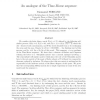Free Online Productivity Tools
i2Speak
i2Symbol
i2OCR
iTex2Img
iWeb2Print
iWeb2Shot
i2Type
iPdf2Split
iPdf2Merge
i2Bopomofo
i2Arabic
i2Style
i2Image
i2PDF
iLatex2Rtf
Sci2ools
COMBINATORICS
2007
2007
An Analogue of the Thue-Morse Sequence
We consider the finite binary words Z(n), n ∈ N, defined by the following selfsimilar process: Z(0) := 0, Z(1) := 01, and Z(n + 1) := Z(n) · Z(n − 1), where the dot · denotes word concatenation, and w the word obtained from w by exchanging the zeros and the ones. Denote by Z(∞) = 01110100 . . . the limiting word of this process, and by z(n) the n’th bit of this word. This sequence z is an analogue of the Thue-Morse sequence. We show that a theorem of Bacher and Chapman relating the latter to a “Sierpi´nski matrix” has a natural analogue involving z. The semi-infinite self-similar matrix which plays the role of the Sierpi´nski matrix here is the zeta matrix of the poset of finite subsets of N without two consecutive elements, ordered by inclusion. We observe that this zeta matrix is nothing but the exponential of the incidence matrix of the Hasse diagram of this poset. We prove that the corresponding M¨obius matrix has a simple expression in terms of the zeta matri...
| Added | 12 Dec 2010 |
| Updated | 12 Dec 2010 |
| Type | Journal |
| Year | 2007 |
| Where | COMBINATORICS |
| Authors | Emmanuel Ferrand |
Comments (0)

